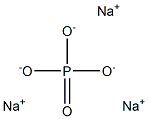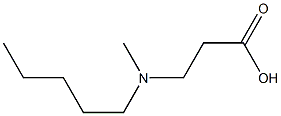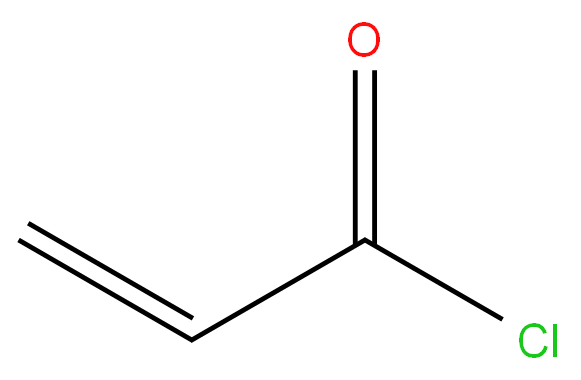Acryloyl chloride
Synonym(s):2-Propenoyl chloride;Acrylic acid chloride;Acryloyl chloride
- CAS NO.:814-68-6
- Empirical Formula: C3H3ClO
- Molecular Weight: 90.51
- MDL number: MFCD00000731
- EINECS: 212-399-0
- Update Date: 2025-03-06 08:32:39

What is Acryloyl chloride?
Chemical properties
Acryloyl chloride is a highly flammable, polymerizable, and toxic (inhalation), light yellow liquid. A lacrimator.
The Uses of Acryloyl chloride
Acryloyl chloride is used in the production of plastics. It plays an important role in the preparation of acrylate monomers and polymers. It also acts as a substrate for cross-metathesis. Further, it is utilized in organic synthesis for the introduction of acrylic groups into other compounds.
Synthesis Reference(s)
Journal of the American Chemical Society, 72, p. 72, 1950 DOI: 10.1021/ja01157a020
General Description
Acryloyl chloride is a liquid. Boiling point 75°C. Used to make plastics. Polymerization in a closed container can cause pressurization and explosive rupture.
Air & Water Reactions
Polymerizes readily upon exposure to oxygen in the air. Reacts exothermically with water to give hydrochloric acid and acrylic acid.
Reactivity Profile
Acrylyl chloride is incompatible with strong oxidizing agents, alcohols, amines, alkali. Polymerizes readily upon exposure to oxygen. May react vigorously or explosively if mixed with diisopropyl ether or other ethers in the presence of trace amounts of metal salts [J. Haz. Mat., 1981, 4, 291].
Fire Hazard
When heated to decomposition, Acrylyl chloride emits toxic fumes of chlorides. Decomposes in water.
Potential Exposure
May be used as a monomer in preparation of specialty polymers or as a chemical intermediate
Shipping
UN3383 Poisonous Toxic by inhalation liquid, flammable, n.o.s. with an LC50 # 200 mL/m3 and saturated vapor concentration ≥500 LC50, Hazard class: 6.1; Labels: 6.1-Poisonous materials, 3-Flammable liquid, Technical Name Required, Inhalation Hazard Zone A. UN2924 Flammable liquids, corrosive, n.o.s., Hazard Class: 3; Labels: 3-Flammable liquid, 8-Corrosive material, Technical Name Required
Incompatibilities
Use MEHQ (monomethyl ether of hydroquinone) as an inhibitor. Incompatible with oxidizers, polymerizes on contact with oxygen; alcohols, amines, alkalis. Reacts violently with water, releasing hydrochloric acid and acrylic acid. Attacks some metals.
Properties of Acryloyl chloride
| Melting point: | 76 °C(Solv: isopropyl ether (108-20-3)) |
| Boiling point: | 72-76 °C (lit.) |
| Density | 1.114 g/mL at 25 °C (lit.) |
| vapor density | >1 (vs air) |
| vapor pressure | 1.93 psi ( 20 °C) |
| refractive index | n |
| Flash point: | 61 °F |
| storage temp. | 2-8°C |
| solubility | Chloroform (Soluble), Methanol (Slightly) |
| form | Oil |
| color | Colourless to Pale Yellow |
| Water Solubility | Miscible with water. |
| Sensitive | Moisture & Light Sensitive |
| BRN | 635744 |
| Exposure limits | ACGIH: TWA 5 mg/m3 (Skin) NIOSH: TWA 5 mg/m3 |
| Stability: | Stable, but reacts violently with water. Incompatible with alcohols, oxidizing agents, strong bases. Light-sensitive. Highly flammable. |
| CAS DataBase Reference | 814-68-6(CAS DataBase Reference) |
| NIST Chemistry Reference | 2-Propenoyl chloride(814-68-6) |
| EPA Substance Registry System | Acrylyl chloride (814-68-6) |
Safety information for Acryloyl chloride
| Signal word | Danger |
| Pictogram(s) |
 Flame Flammables GHS02  Corrosion Corrosives GHS05  Skull and Crossbones Acute Toxicity GHS06 |
| GHS Hazard Statements |
H225:Flammable liquids H290:Corrosive to Metals H302:Acute toxicity,oral H314:Skin corrosion/irritation H330:Acute toxicity,inhalation |
| Precautionary Statement Codes |
P210:Keep away from heat/sparks/open flames/hot surfaces. — No smoking. P280:Wear protective gloves/protective clothing/eye protection/face protection. P301+P312:IF SWALLOWED: call a POISON CENTER or doctor/physician IF you feel unwell. P303+P361+P353:IF ON SKIN (or hair): Remove/Take off Immediately all contaminated clothing. Rinse SKIN with water/shower. P305+P351+P338:IF IN EYES: Rinse cautiously with water for several minutes. Remove contact lenses, if present and easy to do. Continuerinsing. |
Computed Descriptors for Acryloyl chloride
| InChIKey | HFBMWMNUJJDEQZ-UHFFFAOYSA-N |
Acryloyl chloride manufacturer
New Products
Methyl (R)-1-Boc-4,4-difluoropyrrolidine-2-carboxylate 2,2-Difluoropropylamine hydrochloride tert-butyl 3-bromoazetidine-1-carboxylate (R)-1-Boc-3-hydroxypyrrolidine DIFLUOROACETIC ANHYDRIDE 2,2-Difluoropropionic acid Diallylamine, 99% Calcium hydroxide, 95% Aluminum oxide, basic 2-Bromophenylacetonitrile, 97% L-tert-Leucine,97% N-Hydroxy-2-methylpropanimidamide 4-(3,4-Dichlorophenyl)-3,4-Dihydro-N-Methyl-1-(2H)-Naphthalenimine (Schiff Base) 2-AMINO-3,5-DIBROMO BENZALDEHYDE [ADBA] L-Glutamic Acid Dimethyl Ester Hcl 10-Methoxy-5H-dibenz[b,f]azepine 5-Cyanophthalide N, N-Carbonyldiimidazole (CDI) Dibenzoyl Peroxide Titanium Dioxide 2-(Methylthio) Benzonitrile Sodium Acetate Anhydrous Allopurinol 1,5-DibromopentaneRelated products of tetrahydrofuran








You may like
-
 Acryloyl chloride 99%View Details
Acryloyl chloride 99%View Details
814-68-6 -
 Acryloyl Chloride 814-68-6 98%View Details
Acryloyl Chloride 814-68-6 98%View Details
814-68-6 -
 Acryloyl chloride 814-68-6 98%View Details
Acryloyl chloride 814-68-6 98%View Details
814-68-6 -
 Acryloyl chloride 98%View Details
Acryloyl chloride 98%View Details -
 Acryloyl chloride 99%View Details
Acryloyl chloride 99%View Details
814-68-6 -
 814-68-6 Acryloyl chloride 98%View Details
814-68-6 Acryloyl chloride 98%View Details
814-68-6 -
 Acryloyl chloride, stabilized with 400ppm phenothiazine CAS 814-68-6View Details
Acryloyl chloride, stabilized with 400ppm phenothiazine CAS 814-68-6View Details
814-68-6 -
 Acryloyl Chloride 98% CAS 814-68-6View Details
Acryloyl Chloride 98% CAS 814-68-6View Details
814-68-6
